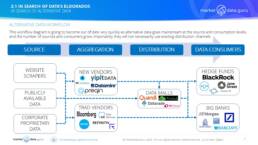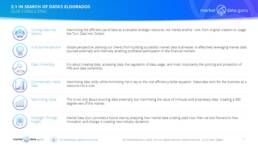WHY BE IN THE MARKET DATA BUSINESS?
A successful market data business is great news for any company.
One small large caveat, first it has to be set up, and second the available data has to be in demand. This begs the most fundamental question, ‘What is the market looking and will pay for?’
In a series of 6 short articles we are going to briefly examine
1.Today in this article ‘Alternative Data’
2.Tomorrow we follow with ESG Data, then in sequence:
3.Indices & Benchmarks
4.Commodities Data
5.Trading Data
6.Historical Data
One of the immediate things to notice about these 6 topics is how inter-related they are, and how they each fit into the data workflow complementing each other. The result is that the need for a more diverse range of datasets requires new sources and new suppliers, the analysis of the data needs new tools, and everything is benchmarked for performance.
This paves the way for participants across the data workflow chain to benefit.
First up, Alternative Data.
ALTERNATIVE DATA: WHAT IS THE MARKET LOOKING FOR?
Refinitiv defines Alternative Data as ‘non-traditional data that can provide an indication of future performance of a company outside of traditional sources, such as company filings, broker forecasts, and management guidance. This data can be used as part of the pre-trade investment analysis, as well as helping investors monitor the health of a company, industry, or economy.’
In layman’s terms, data sourced outside from financial markets, i.e. alternative data comprises the majority of data that now exists and will come into existence in the future. However, on its own Alternative Data will not drive an investment strategy, or trigger a trade, its value is generating real world inputs into the analytics and tools that facilitate the execution of those investment strategies.
Grand View Research in their latest report, (www.grandviewresearch.com/industry-analysis/alternative-data-market) found:
- In 2021 the global alternative data market size was valued at US$2.7 Billion
- From 2022 the expected CAGR will be 54.4% up to 2030
- By 2030 the global alternative data market size is estimated to be US$143.3 Billion
Alternative Investment Management Association’s recent research revealed (https://builtin.com/fintech/alternative-data):
- There are 445 identifiable Alternative Data providers, up from 20 in 1990, and this is growing (Partner SS&C)
- 50% of all US Investment firms use Alternative Data (Partner Bank of America)
- 34% of US Hedge Funds are newly investing in Alternative Data (Partner Simmons & Simmons and Seward & Kissel)
To avoid confusion these are Providers, not Sources, there is an important difference, Providers are either getting their data from the actual sources, and/or scrapping websites for information. Data provenance and integrity are understated concerns in the Alternative Data universe.
WHAT IS DRIVING THE ALTERNATIVE DATA MARKET NOW?
At the moment the primary drivers are retail, credit card based, and geospatial, data tracking consumer activity at point of sale, while the data consumers tend to be Hedge Funds seeking an edge.
Yet this accounts for only one, albeit significant, part of the potential market and opportunities for participants in terms of:
- Coverage, expanding to other sectors, notably manufacturing, agriculture, and deeper into logistics
- Sources, as despite the accuracy of the primary drivers, these are secondary sources to the companies and organisations where the activity occurs, and therefore should be entering the alternative data market themselves
- Data Consumers, expanding to commercial banks, investment banks, asset managers, and the sources themselves
ALTERNATIVE DATA TREASURES
Belatedly financial institutions have worked out that commercial data provides excellent insights into the trends and prospects of companies, markets, production, supply, and demand as leading indicators. While this sounds a lot like micro-economic data, it is not, we are looking at operational information which provides a solid starting point for both a fundamental and quantitative view of investment decision making.
Most of this data is unstructured and locked away, siloed, within companies. So how do we get hold of these hidden treasures? There appears to be 3 immediate options:
1.Third parties scrape the data from public sources. This is the current ‘go to’ method, however it does seem to be an intermediate step before:
2.Companies themselves unlock their data and build their own information businesses. This could appeal to conglomerates, multi-nationals, and media enterprises, and intriguingly governments, local governments, government agencies, which could all commercialise data, or,
3.These entities outsource this to third parties for management and sales, for instance a vendor (Bloomberg, Refinitiv, S&P/IHS) or professional services business (Accenture, EY, PriceWaterhouse)
DIGGING FOR ALTERNATIVE DATA TREASURES
New sources themselves also have to ask themselves questions before entering the Alternative Data game.
- Where to start?
- Data Inventory. What data do I have? How can it be accessed? Are there barriers to commercialisation?
- Data Value. What is the data’s unique properties? How does the data compare to potential competitors?
- Building a Business Model. Who will use the data? How will it be used?
Building Relationships. Who should I partner with, for what purpose, and mutual benefit?

FIRST PORTS OF CALL
Right now, and for the immediate future, the first places for both Alternative Data sources and consumers to go are the intermediaries, i.e. data vendors with varying business models. Sources do not have the reach to find clients directly, and consumers don’t have the resources to find all potential sources. (Though of course www.marketdata.guru can help with its business listings).
The vendors can be divided into two types:
1.New ‘data mall’ aggregators which supply data on a menu driven basis, and,
2.Traditional market data vendors which offer more structured pricing models
Both have their merits depending upon availability, the relative need for data and updates, and the business model employed by the data source. Currently the update frequency of most alternative data is daily or slower, which lowers the barrier to entry, however once delivery changes to faster than daily then the vendor dynamics change.
PROBLEMS IN PARADISE
The problem now for all parties is that Alternative Data Sources (like ESG) have weak business models, especially in first data principles, i.e.
- Do not establish clear data ownership and Intellectual Property Rights (IPRs)
- Have not created accurate data asset inventories detailing what is available and the associated properties of the data, especially relating to accuracy, consistency, and timeliness
- Pricing models do not differentiate between sales and licences of data, linked to IPRs
- Pricing models are not transparent inconsistent and inefficient, too often reliant upon ad hoc negotiation
These are easily surmountable by establishing a clear and coherent business strategy
ALTERNATIVE DATA SUMMARY
Why has Alternative Data become an important commodity? As many writers have surmised the answers are obvious:
1.There is only so much financial data being produced, and with many financial institutions hitting saturation point and using the same data, something else is desired to differentiate their investment strategies
2.The models and analytics being used to leverage financial data tend to optimise towards common configurations depending upon the preferred investment strategies which means the parameters must change, and the best one to start with is, the data inputs.
The great beauty of Alternative Data is it expands the universe of available information, this benefits all segments of the market:
- Investors gain a broader view when making their trading decisions, greater information choices
- The market share pie increases for traditional vendors and new vendors entering the arena, greater supplier choices
- Accessibility improves as the range of distribution channels broadens, greater relationship choices
- Sources gain new revenue flows, which can improve overall margins, greater investment choices
In the future we could well see the development of a virtuous circle, if even a good minority of the potential data sources come to the party.
Therein lies the secret, companies and organisations need to analyse what data they have, how it is structured, and how to monetise their data, either to maximise its value internally for making commercial decisions, or to create a data business for external revenue generation.
The obvious strategy would be to do both, but is that the always best option?
Conclusion. Alternative data looks set to go mainstream in financial markets, and the prospects for all participants looks very favourable
Keiren Harris 05 July 2022
Please contact info@marketdata.guru for a pdf copy of the article
For information on our consulting services please email knharris@datacompliancellc.com


